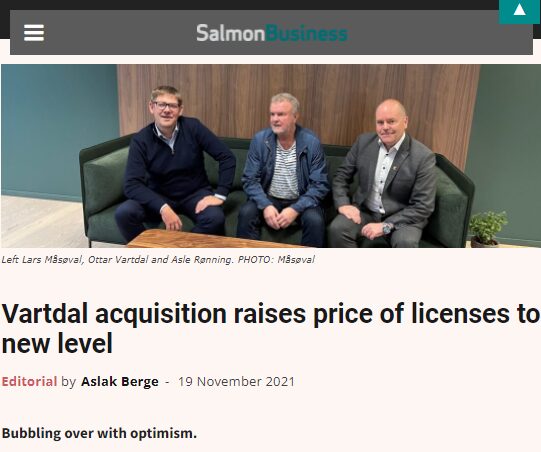 Verð á framleiðslukvóta í sjókvíaeldi á laxi hefur farið stöðugt hækkandi á undanförnum árum í Noregi. Ástæðan er einföld eins og farið er yfir í meðfylgjandi grein fagmiðilsins Salmon Business:
Verð á framleiðslukvóta í sjókvíaeldi á laxi hefur farið stöðugt hækkandi á undanförnum árum í Noregi. Ástæðan er einföld eins og farið er yfir í meðfylgjandi grein fagmiðilsins Salmon Business:
„Umhverfisfótsporið er svo stórt, sérstaklega af völdum laxalúsar, í opnu sjókvíaeldi við strandlengjuna að stjórnvöld munu ekki leyfa frekari vöxt að ráði. Sama staða er í flestum öðrum löndum þar sem sjókvíaeldi er stundað,“ segir í grein ritstjóra útgáfunnar.
Íslensk stjórnvöld eru hins vegar á allt annarri leið. Sjókvíaeldið hefur fengið að vaxa hratt hér á undanförnum og mun verða 150 prósent meira að umfangi en nú, ef ekki verður gripið í taumana.
Tugþúsund tonna framleiðsluleyfum hefur verið úthlutað hér svotil endurgjaldslaust á sama tíma og norsk fyrirtæki greiða milljónir fyrir hvert tonn í heimalandi sínu.
Andvaraleysi stjórnvalda gagnvart þessum iðnaði hefur verið ótrúlegt. Á það við um að þjóðin fái greitt fyrir afnot af hafsvæðum í hennar eigu sem þessi fyrirtæki nýta fyrir starfsemi sína, en umfram allt hafa stjórnvöld þó sofið á verðinum gagnvart vernd náttúru og lífríkis landsins, sem er langdýrmætasti lífeyrissjóður þjóðarinnar.
Bubbling over with optimism.
Above all, it signalled a strengthened confidence in the future. In the summer of 2019, when SalmonBusiness was able to peep behind the curtain of the bidding war for K. Strømmen Lakseoppdrett in Bremanger, many people raised their eyebrows. It emerged that several players had bid more than NOK 750 million (€75 million) for the small company. K. Strømmen that only had four licenses.
Measured in price per license, K. Strømmen broke an unofficial record, as Mowi shortly afterwards secured the company for NOK 790 million (€82 million). The trade was settled with 30 per cent in shares in Mowi and 70 per cent in cash.
Rose red
That was 2019. Now, just over two years later, the prospects for returns on salmon licenses are even more rosy. Måsøval just paid NOK 1,521 million (€150 million) for Ottar Vartdal’s farming business.K. Strømmen and the Vartdal group are not completely different. Both have four licenses as their most important and valuable assets. Vartdal also has its own slaughterhouse and freezer (valued at NOK 80 million (€8 million)) and a not insignificant investment in post-smolt. The latter, in particular, sweetened Måsøval’s interest.
Post-smolt production takes place in large tanks on land, and has a capacity to have 670 tonnes of standing biomass. Well utilized, this will result in an annual production on land of approximately 1,400 tonnes of biomass (round weight).
Leap
Even if you adjust the transaction price of NOK 80 million (€8 million) to the slaughterhouse and freezer, and set a spacious price for the post-smolt business, there is no doubt that the price tag per food fish license has made a sharp jump in the 29 months that have passed since the Strømmen acquisition.The reasons for the reprising are obvious: The environmental footprint, especially in the form of salmon lice, from farming in open cages along the coast, is so extensive that the authorities do not allow significant growth. The message is the same in most other salmon-producing countries. The supply side globally thus shows modest growth. However, the growth in demand is strong. Market leader Norway has, for example, sold 17 per cent more salmon, at almost three kroner higher spot price, this year compared to the same period last year.
Rich people
In a market where demand runs faster than supply, the price outlook is good. This applies to both the salmon and the permits to produce it.When Norwegian financial magazine Kapital published its annual list of the country’s 400 richest people two months ago, 38 of them were engaged in fish farming. Following the Vartdal acquisition, the Kapital editorial staff will have to adjust their spreadsheets when valuing their farming assets.
The odds are low that there will be significantly more farmers on the Kapital list next year.
